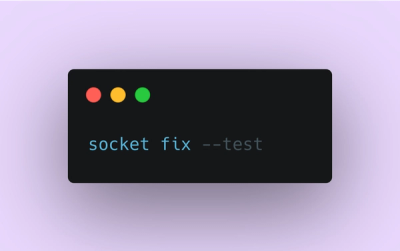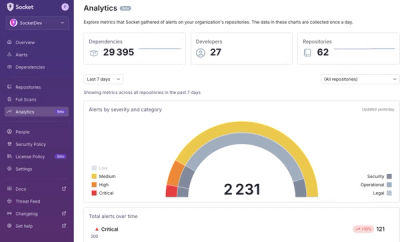
Product
Introducing Socket Fix for Safe, Automated Dependency Upgrades
Automatically fix and test dependency updates with socket fix—a new CLI tool that turns CVE alerts into safe, automated upgrades.
backendless-request
Advanced tools
Simple Node.js and Browser REST client
backendless.js => ~ 28 KB
backendless.min.js => ~ 11 KB
for installing just execute the following command:
npm i backendless-request -S
import BackendlessRequest from 'backendless-request';
//or
const BackendlessRequest = require('backendless-request');
Inside the installed package you can find a dist directory, where are two js files backendless-request.js and backendless-request.min.js
-|
- dist
|-backendless.js
|-backendless.min.js
Get one of the js files into your project
<script src="/path-to-backandless-request-package/dist/backendless-request.js"></script>
you can use minimized file as well
<script src="/path-to-backandless-request-package/dist/backendless-request.min.js"></script>
After that you can use BackendlessRequest from the global scope
BackendlessRequest.get('http://foo.bar/')
BackendlessRequest.get('http://foo.bar/')
.then(result => console.log(result))
.catch(error => console.error(error))
BackendlessRequest.post('http://foo.bar/', { foo: 'bar', bool: true, num: 1 })
.then(result => console.log(result))
.catch(error => console.error(error))
BackendlessRequest.put('http://foo.bar/', { num: 123 })
.then(result => console.log(result))
.catch(error => console.error(error))
BackendlessRequest.delete('http://foo.bar/foo')
.then(result => console.log(result))
.catch(error => console.error(error))
BackendlessRequest.patch('http://foo.bar/foo', { bool: false })
.then(result => console.log(result))
.catch(error => console.error(error))
You can set up request query through .query(query) method
and the library automatically add the query into request url
// RequestUrl: http://foo.bar/some-path?str=some-string&num=123&bool=true&arr=1&arr=2&arr=3&arr=4
BackendlessRequest.get('http://foo.bar/some-path')
.query({ str: 'some-string', num: 123, bool: true, arr: [1, 2, 3, 4] })
.then(result => console.log(result))
.catch(error => console.error(error))
You have an ability to send request body through .send(body) method,
but if don't do that the method will be called with the second argument when you call then or catch method.
BackendlessRequest.post('http://foo.bar/some-path')
.send({ str: 'some-string', num: 123, bool: true, arr: [1, 2, 3, 4] })
.then(result => console.log(result))
.catch(error => console.error(error))
BackendlessRequest.post('http://foo.bar/some-path', { str: 'some-string', num: 123, bool: true, arr: [1, 2, 3, 4] })
.then(result => console.log(result))
.catch(error => console.error(error))
For sending form you should use .form(form) method
BackendlessRequest.post('http://foo.bar/')
.form(form)
.then(result => console.log(result))
.catch(error => console.error(error))
For set up Content-Type header manually you can use .type(contentTypeHeader) method or set it via .set('Content-Type', value) method.
If you pass an object as request body the Content-Type header will be automatically specified as application/json
BackendlessRequest.get('http://foo.bar/')
.set('x-header-key', 'x-header-value')
.set({ 'y-header-key': 'y-header-value', 'z-header-key': 'z-header-value' })
.then(result => console.log(result))
.catch(error => console.error(error))
A request instance might fire events to notify about changing request state:
for subscribing use method .on(<eventName>, callback)
BackendlessRequest.post('http://foo.bar/some-path')
.on('request', req => req.set('my-x-header-key', 'my-x-header-value'))
.on('response', result => console.log('result', result))
.on('error', error => console.log('error', error))
.on('done', (error, result) => console.log('done', { error, result }))
.send({ str: 'some-string', num: 123, bool: true, arr: [1, 2, 3, 4] })
.then(result => console.log(result))
.catch(error => console.error(error))
request - it will be fired before sending request to the server
response - it will be fired when request is successfully completed
error - it will be fired when request is failed
done - it will be fired when request is done, it's a shortcut for response and error
The feature provides you to have some responses cached and reset the cache by the next requests.
Cache tags help you to keep your cache up-to-date
For example you have route to retrieve a list of Persons and you want to cache the result for the same requests,
for it you need to specify a cache tag and set TTL via useCache method,
after that when you do the request again the response will be retrieved from the cache store.
// get list of persons
BackendlessRequest.get('http://your-domain.com/persons')
.cacheTags(['persons'])
.useCache(30 * 1000) // cache time to live is 30 seconds, by default it's 15 seconds
.then(result => console.log(result))
.catch(error => console.error(error))
You can use as many tags as you need
// get list of persons
BackendlessRequest.get('http://your-domain.com/persons')
.cacheTags(['persons', 'friends', 'posts'])
.useCache()
.then(result => console.log(result))
.catch(error => console.error(error))
In many cases you want to reset the cache when do some requests which can change values on the server
// create a new persons
BackendlessRequest.post('http://your-domain.com/persons', { name: 'Bob' })
.cacheTags(['persons'])
.resetCache(true)
.then(result => console.log(result))
.catch(error => console.error(error))
// create a new persons
BackendlessRequest.delete('http://your-domain.com/persons/personId')
.cacheTags(['persons'])
.resetCache(true)
.then(result => console.log(result))
.catch(error => console.error(error))
You can use your own XMLHttpRequest, just replace it for BackendlessRequest namespace.
class MySupperXMLHttpRequest {
open(){
}
...
send(){
}
}
BackendlessRequest.XMLHttpRequest = MySupperXMLHttpRequest
If you want to logging all the requests just set true for verbose
BackendlessRequest.verbose = true
FAQs
Simple Node.js and browser REST client
The npm package backendless-request receives a total of 1,789 weekly downloads. As such, backendless-request popularity was classified as popular.
We found that backendless-request demonstrated a healthy version release cadence and project activity because the last version was released less than a year ago. It has 4 open source maintainers collaborating on the project.
Did you know?

Socket for GitHub automatically highlights issues in each pull request and monitors the health of all your open source dependencies. Discover the contents of your packages and block harmful activity before you install or update your dependencies.

Product
Automatically fix and test dependency updates with socket fix—a new CLI tool that turns CVE alerts into safe, automated upgrades.

Security News
CISA denies CVE funding issues amid backlash over a new CVE foundation formed by board members, raising concerns about transparency and program governance.

Product
We’re excited to announce a powerful new capability in Socket: historical data and enhanced analytics.